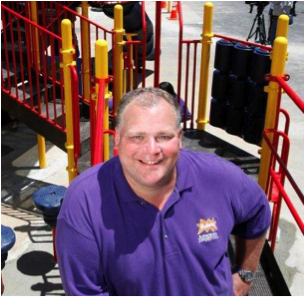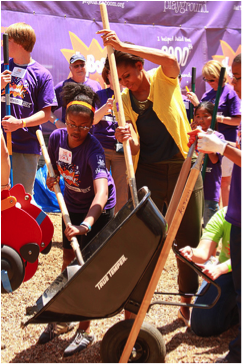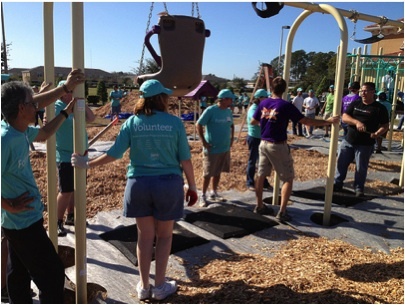Technology for Change: Darell Hammond, KaBOOM!
Singlebrook talks with Darell Hammond, Founder of KaBOOM!, a national non-profit that partners communities with corporations to build playgrounds around the country.
KaBOOM! is dedicated to saving play for America’s children and invigorating local communities around a common cause. In 2011 KaBOOM! celebrated their 15th birthday by building their 2,000th playground in Washington, D.C., and since its founding has engaged over a million volunteers and counting.
Singlebrook: Can you tell us a little about what your organization does and how you got the idea?
 Darell Hammond: More than just building playgrounds, the idea for KaBOOM! started with the general premise of getting communities to fight for something instead of fighting against something. We implemented this by having communities come together to build a playground. Our first pivot in terms of strategy was to open source how we did what we did, so that anybody who wanted to replicate the process could go online and learn how we do it for free. Now we’re about ready to go to our second major pivot. After building playgrounds for many years, we became one of the largest purchasers of playgrounds in the United States, which made us think about not just building more playgrounds but building better playgrounds. We’re going to keep our roots grounded in community building and in our replication and scale, but also add the dimension of trying to solve the problem of kids not getting the type of active and balanced play they need every day. This applies particularly to the 16 million U.S. kids living in poverty.
Darell Hammond: More than just building playgrounds, the idea for KaBOOM! started with the general premise of getting communities to fight for something instead of fighting against something. We implemented this by having communities come together to build a playground. Our first pivot in terms of strategy was to open source how we did what we did, so that anybody who wanted to replicate the process could go online and learn how we do it for free. Now we’re about ready to go to our second major pivot. After building playgrounds for many years, we became one of the largest purchasers of playgrounds in the United States, which made us think about not just building more playgrounds but building better playgrounds. We’re going to keep our roots grounded in community building and in our replication and scale, but also add the dimension of trying to solve the problem of kids not getting the type of active and balanced play they need every day. This applies particularly to the 16 million U.S. kids living in poverty.
SB: Can you talk a little more about your first pivot and the decision to make your formula for building playgrounds freely available online?
DH: About 7 years into our existence, we thought that it was nice building playgrounds the way that we were building playgrounds, but we were also increasingly concerned with the amount of applications we were receiving to build playgrounds— it was always a between 7 - 10 to 1 ratio to the amount we could actually build. The demand was greater than what we could supply, and we weren’t interested in scaling up the organization. We wanted to scale outcomes and impact rather than be the largest organization, and we needed to do something complementary to what we were already doing. We found that with the rise of the internet, a new approach would be to take our intellectual property and give that away for free, so that anyone who wanted to independently replicate what we do would be able to. You can find that information at Our Dream Playground.
SB: In addition to Our Dream Playground, you guys have utilized technology to develop the Map of Play, which plots local play spaces around the country. Can you give us more insight into that?
DH: The Map of Play, interestingly, was made to gather the data that’s needed to make better informed resource allocation decisions. For example, I’m from Chicago, and the Chicago District’s website used to show the Washington Park playground as it was built almost 24 years ago, not as it is in its current condition— it was torn down about 10 years ago. In developing the Map of Play, we wanted to crowdsource photos and ratings of where people actually do play to provide a richer and deeper experience, and also provide information regarding the quantity and quality of the play spaces. Then we could use that data set with city governments, policy makers and resource allocators to make better-informed decisions on where resources should go.
SB: How did you go about partnering with corporations to build playgrounds, especially in the early stages of KaBOOM?
DH: This is probably one of the innovations that we’re most known for. What we learned from very early on was that we needed to understand what it cost to build a playground and we needed to charge people that amount. We also needed to consistently deliver excellent service. That way, we weren’t always out looking for new customers, because often the customers we already had would want to do it again. Our growth has always come from the base; people repeating and growing, and from gaining high-quality referrals from happy customers who told their friends and colleagues at other corporations that they should be doing this too. It was an ‘understand your cost, charge people for what’s needed to cover that, and deliver an excellent product and service’ approach. This was not easy; it takes discipline and sometimes saying no. Frankly, the partner development effort became a self-fulfilling prophecy.
SB: KaBOOM! is one of the largest nonprofits in the country and has deservedly garnered national attention throughout the years. What have been some of the most exciting times for you personally?
 DH: I think one of our most inspiring moments was very early on. Ben and Jerry’s couldn’t afford to build a lot of playgrounds with us, but they loved what we were doing. So, they honored us with the first ever nonprofit ice cream flavor called “KaBerry KaBoom”. It was a blueberry and strawberry ice cream with white fudge-covered poprocks. That was a real legitimizer for us because they loved us so much, and it also gave us an incredible amount of credibility and visibility.
DH: I think one of our most inspiring moments was very early on. Ben and Jerry’s couldn’t afford to build a lot of playgrounds with us, but they loved what we were doing. So, they honored us with the first ever nonprofit ice cream flavor called “KaBerry KaBoom”. It was a blueberry and strawberry ice cream with white fudge-covered poprocks. That was a real legitimizer for us because they loved us so much, and it also gave us an incredible amount of credibility and visibility.
I also take a tremendous amount of personal pride that, since Hurricane Katrina, we have built over 174 playgrounds in the 90-mile area devastated by the hurricane. We did it against a lot of odds. People told us play was a luxury, and that we were directing resources away from building housing or schools. In the process, they were losing sight of the kids, and we needed to do more by the kids.
And, yes, there’s our 15th birthday, and my book (KaBOOM! A Movement to Save Play) hitting the New York Times Bestsellers List, which was an incredible validator. And there’s been the wonderful support we’ve received from every first lady since we began, from Mrs. Clinton to Mrs. Bush, and then continuing with Mrs. Obama. But some of our biggest successes are actually things that people don’t know we’ve been a part of. I’m really proud of the work we’re doing around scaling up citizen activism. For example, when recess is eliminated from Chicago schools, instead of KaBOOM! having to go in and be the only one trying to stand up for play, there are local organizations and citizen activists on the ground that get the decision reversed and recess brought back. We’ll never get credit for it, but we’re not in it for the credit; we’re in it for the cause.
SB: Will you elaborate more on why play is so important?
 DH: I want to start by saying again that we didn’t start the organization to be a playground builder. We were very interested in how we could get communities to fight for something instead of against something. We used the process of building a playground as a sort of Trojan horse to get the community to work on three pillars: a common cause, the well-being and health of communities, achievable wins, breaking up the project into bite-size pieces so that it wasn’t too large to accomplish, and finally, cascading steps of courage and confidence that says, ‘If we can build this playground, what else can we tackle in our community together?’ That’s why we started KaBOOM!, and that’s still true today
DH: I want to start by saying again that we didn’t start the organization to be a playground builder. We were very interested in how we could get communities to fight for something instead of against something. We used the process of building a playground as a sort of Trojan horse to get the community to work on three pillars: a common cause, the well-being and health of communities, achievable wins, breaking up the project into bite-size pieces so that it wasn’t too large to accomplish, and finally, cascading steps of courage and confidence that says, ‘If we can build this playground, what else can we tackle in our community together?’ That’s why we started KaBOOM!, and that’s still true today
Why play matters is that we’re finding kids getting 7 ½ hours of screen time a day, we’re falling further and further behind, globally, in math and science (24th in math, 31st in science) and 1 in 3 kids are not just overweight, but obese. Lack of play can debilitate physical, intellectual, social, and emotional growth. We need to take play more seriously. As someone who builds playgrounds with communities, we have to do it in a different way.
SB: What have been some of your biggest challenges over the years?
DH: I think the biggest challenges are that not all things are equally worth doing. From a strategy perspective, you have to choose the clearest, most accountable things and you’ve got to be able to understand how you’re going to get them paid for. There are a lot of good ideas that you can’t get paid for, so they’re left on the cutting room floor somewhere. I think the most challenging piece is redefining what success looks like. Success doesn’t mean being in the paper or being on this list or that list— it’s about fundamentally closing the gap on the 16 million kids living in poverty in the United States that are not getting the kind of active play they need. It’s about taking an issue that people don’t necessarily care about, or think that they care about, and trying to make it a priority in this very resource-constrained world in regards to local budgets and time allocation.
SB: Lastly, do you have any advice for aspiring social entrepreneurs?
 DH: The first thing I would ask is, ‘Do I really need to start something, or can I make something else better?’Second, if you’re the smartest person in the room, you’re in the wrong room. You need to surround yourself with people who are going to challenge— challenge you and challenge your ideas. In doing so, the collective wisdom is going to be greater than what you had. If you need to be the smartest person in the room, I don’t think you’re going to be able to go very far, very fast.I would also say that no one sector has a monopoly on social change. It doesn’t have to be a non-profit, and it doesn’t have to be a for-profit—it could be the government—but find something that you’re passionate about and use any and every lever at your disposal to try and solve it on the scale that it exists.
DH: The first thing I would ask is, ‘Do I really need to start something, or can I make something else better?’Second, if you’re the smartest person in the room, you’re in the wrong room. You need to surround yourself with people who are going to challenge— challenge you and challenge your ideas. In doing so, the collective wisdom is going to be greater than what you had. If you need to be the smartest person in the room, I don’t think you’re going to be able to go very far, very fast.I would also say that no one sector has a monopoly on social change. It doesn’t have to be a non-profit, and it doesn’t have to be a for-profit—it could be the government—but find something that you’re passionate about and use any and every lever at your disposal to try and solve it on the scale that it exists.
Finally, I would say that everything does not scale overnight. One of the increasing concerns that I see is that, when I started and when a lot of other people started, they put one foot in front of themselves and one pant leg on at a time. Our next success was determined by our last success. That’s the difference between having a business plan for solving the problem versus actually rolling up your sleeves and doing the work.
Learn more about KaBOOM! at kaboom.org.
How can you support KaBOOM!?
Now is the time to act boldly to ensure all kids get the childhood they deserve. Read why in “When Good is Not Good Enough,” co-authored by the Founder and CEO of KaBOOM!, Darell Hammond, online now in the Stanford Social Innovation Review.
Seven-year-old Ashley’s dream of a new playground becomes a reality in My Dream Playground, the latest children’s book by KaBOOM!. Inspired by the true story of the first KaBOOM! build, My Dream Playground is available now.
***
Singlebrook’s T4C campaign spotlights entrepreneurs and organizations that are using technology in unique ways to scale their ideas and create a massive impact. We are also creating our own high impact T4C projects. Check them out at: singlebrook.com/t4c. Share your stories of T4C or other inspirational resources and tips on Twitter (@Singlebrook) using #T4C and on the T4C Facebook group, or contact us to be spotlighted in an upcoming feature interview or blog article!